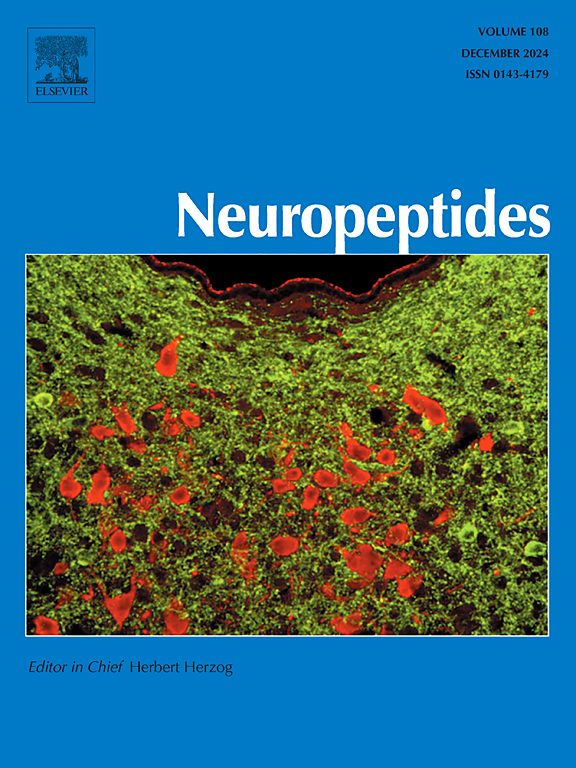Modulation of neuropathological pathways by bioactive peptides and proteins/polypeptides: Targeting oxidative stress in neurodegenerative diseases
IF 2.7
3区 医学
Q3 ENDOCRINOLOGY & METABOLISM
引用次数: 0
Abstract
Neurodegenerative disorders (NDDs) pose a growing global health burden, primarily due to their progressive nature and the limited efficacy of existing treatments. Bioactive peptides and proteins/polypeptides, particularly those derived from dietary and natural sources, show promise in modulating neurobiological pathways central to neurodegeneration. This review aims to critically examine the neuroprotective roles of Bioactive peptides and proteins/polypeptides in NDDs, elucidating their mechanisms of action, potential therapeutic applications in conditions like Alzheimer's, Parkinso's disease, Huntington's disease, and others, as well as the trends in peptide-based therapeutics. Bioactive peptides and proteins/polyspeptides, such as NGF, BDNF, GDNF, Semax, and Exendin-4, have been found to modulate several critical mechanisms, including the reduction of oxidative stress (OS), inhibition of neuroinflammation, preservation of mitochondria, and enhancement of synaptic plasticity. These peptides have demonstrated efficacy in preclinical and early-phase clinical trials across a spectrum of NDDs. Delivery challenges, such as blood-brain barrier (BBB) permeability and enzymatic degradation, have been acknowledged. Ongoing innovations in peptide engineering, nanoparticle-based delivery systems, CRISPR-assisted design, and AI-driven screening are addressing these limitations. By targeting multiple pathogenic mechanisms simultaneously, peptide-based therapeutics present a rational and innovative approach to NDD management. Their multifunctional action profiles and ability to target specific molecular pathways highlight their potential as next-generation neuroprotective agents. However, future clinical validation and advanced strategies are essential for translating these promising molecules into effective treatments.
生物活性肽和蛋白/多肽对神经病理通路的调节:针对神经退行性疾病中的氧化应激
神经退行性疾病(ndd)造成了日益严重的全球健康负担,主要是由于其进行性和现有治疗方法的有效性有限。生物活性多肽和蛋白质/多肽,特别是来自膳食和天然来源的生物活性多肽,在调节神经退行性变的中枢神经生物学通路方面显示出前景。本综述旨在批判性地研究生物活性肽和蛋白质/多肽在ndd中的神经保护作用,阐明其作用机制,在阿尔茨海默病,帕金森病,亨廷顿病等疾病中的潜在治疗应用,以及基于肽的治疗方法的发展趋势。生物活性肽和蛋白/多肽,如NGF、BDNF、GDNF、Semax和Exendin-4,已被发现可以调节几种关键机制,包括减少氧化应激(OS)、抑制神经炎症、保存线粒体和增强突触可塑性。这些肽已在临床前和早期临床试验中证明了对ndd的有效性。递送挑战,如血脑屏障(BBB)的渗透性和酶降解,已经得到承认。肽工程、基于纳米颗粒的递送系统、crispr辅助设计和人工智能驱动的筛选等方面的持续创新正在解决这些限制。通过同时针对多种致病机制,基于肽的治疗方法为NDD的治疗提供了一种合理和创新的方法。它们的多功能作用特征和靶向特定分子途径的能力突出了它们作为下一代神经保护剂的潜力。然而,未来的临床验证和先进的策略对于将这些有希望的分子转化为有效的治疗方法至关重要。
本文章由计算机程序翻译,如有差异,请以英文原文为准。
求助全文
约1分钟内获得全文
求助全文
来源期刊

Neuropeptides
医学-内分泌学与代谢
CiteScore
5.40
自引率
6.90%
发文量
55
审稿时长
>12 weeks
期刊介绍:
The aim of Neuropeptides is the rapid publication of original research and review articles, dealing with the structure, distribution, actions and functions of peptides in the central and peripheral nervous systems. The explosion of research activity in this field has led to the identification of numerous naturally occurring endogenous peptides which act as neurotransmitters, neuromodulators, or trophic factors, to mediate nervous system functions. Increasing numbers of non-peptide ligands of neuropeptide receptors have been developed, which act as agonists or antagonists in peptidergic systems.
The journal provides a unique opportunity of integrating the many disciplines involved in all neuropeptide research. The journal publishes articles on all aspects of the neuropeptide field, with particular emphasis on gene regulation of peptide expression, peptide receptor subtypes, transgenic and knockout mice with mutations in genes for neuropeptides and peptide receptors, neuroanatomy, physiology, behaviour, neurotrophic factors, preclinical drug evaluation, clinical studies, and clinical trials.
 求助内容:
求助内容: 应助结果提醒方式:
应助结果提醒方式:


